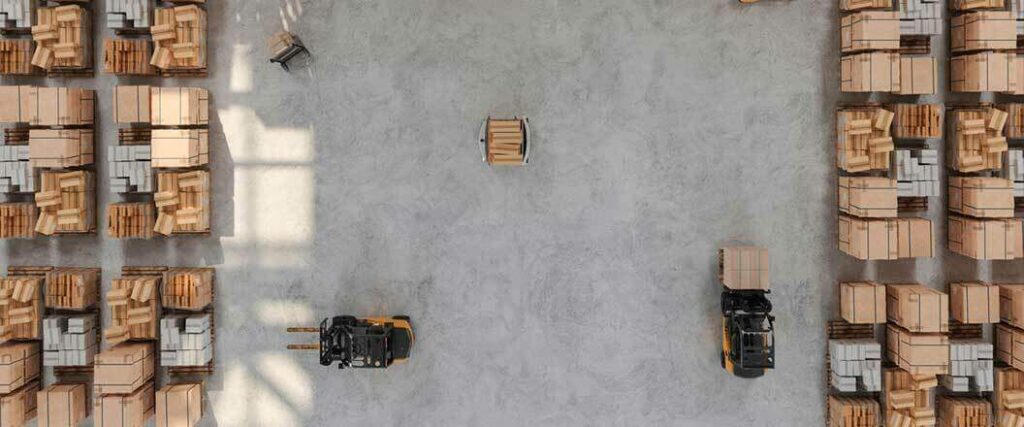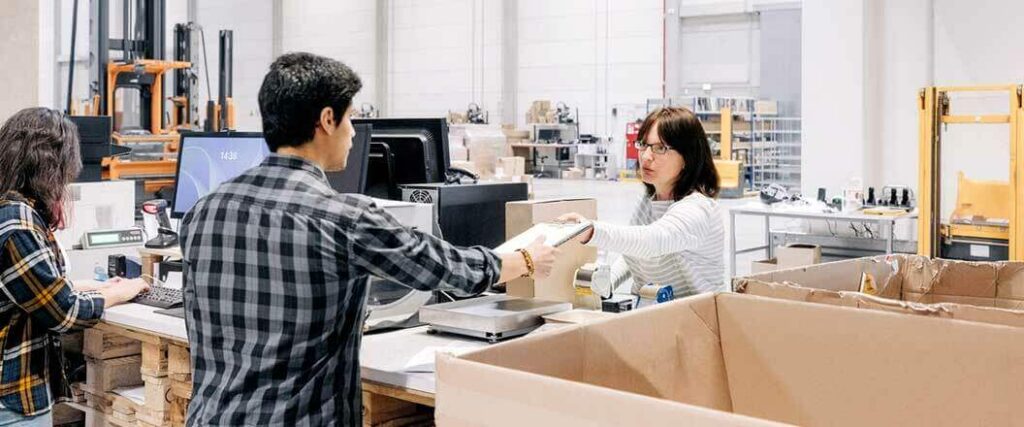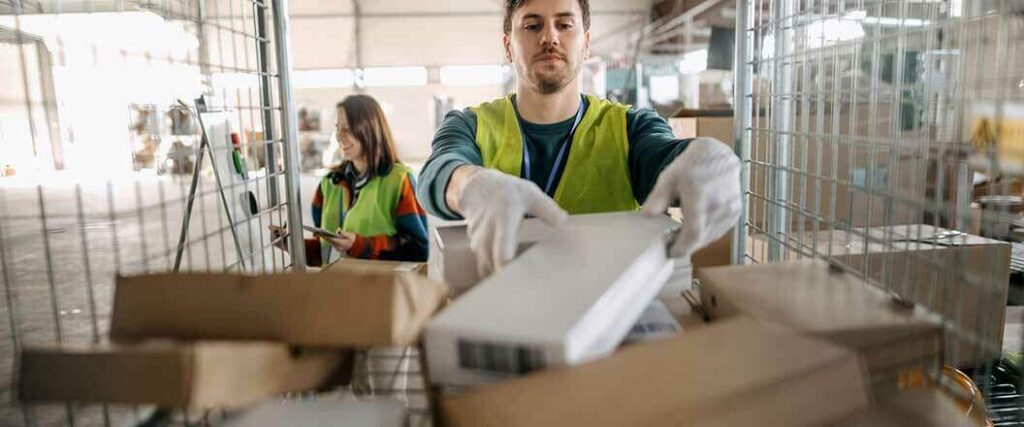
 Copy URL to Clipboard
Copy URL to Clipboard
Pick and pack warehouse systems are crucial for businesses aiming to streamline their distribution and shipping processes. Without these facilities, businesses often face delays and inventory mishaps. These problems can bleed into customer satisfaction and hurt a company’s reputation.
The Fulfillment Management Association defines a pick and pack warehouse as a specialized type of storage facility. Rather than storing bulk goods, items are picked individually or in small quantities and then packed for shipping directly to customers. This system minimizes storage times and accelerates order fulfillment.
A pick and pack warehouse has many benefits that businesses should know about before using the services of these facilities.
Table of Contents
While regular warehouses often store large quantities of products for extended periods, pick and pack facilities are tailored for speed and efficiency. Distribution centers like these use different methods to provide this level of service.
This includes:
As soon as an order comes in, items are selected from storage locations inside a warehouse. After this process, packing occurs right away, which reduces the amount of time it usually takes to prepare a shipment. Since both of these processes are done in quick succession, goods are transported much more quickly than other loads of cargo.
Many pick and pack warehouses have a minimal amount of storage space. These facilities are best suited to carry goods that are in high demand amongst consumers and have quick turnover.

Pick and pack warehouse services move very quickly. The process is so fast, it’s hard to tell that multiple steps occur. However, there are distinct parts of this warehouse logistics service shippers should know about.
This includes:
Each step must be completed correctly to ensure the operation works as efficiently as possible.
The first part of the warehouse pick and pack process is the receipt of order. Upon the placement of goods, details are transmitted to the facility. This happens when products are bought online, through a phone call or any other type of sales channel.
The receipt of order can be entered into a warehouse system in the following ways:
Many businesses use e-commerce platforms that can integrate directly with warehouse management systems. As soon as an order is placed, its details are sent to their facility without human intervention.
In some businesses, especially smaller ones, the order might be communicated manually. Therefore, someone will need to enter the order details into the warehouse system.
Once a receipt of order is received, the following steps occur:
The warehouse staff or system verifies the order to ensure all details are correct. This might include checking the quantities of items ordered and the shipping address. Based on how quickly orders need to be sent, some loads might be tagged as 'urgent' or 'express.'
These labels help the warehouses prioritize orders that need quicker processing and shipping. The warehouse pick and pack system determines the best route for pickers to take, ensuring efficiency in the subsequent processes.
Once the receipt of the order is confirmed and processed, the picking phase begins. The efficiency of this stage can greatly affect the overall speed of order fulfillment. Workers inside the warehouse will go to specific areas to retrieve the products that were ordered.
Facility personnel use two different methods to carry out this operation:
Every picker is armed with an order list that’s typically on a digital device. It details the items, quantities, and the location of the goods within a warehouse. Once at the location, pickers verify the item against the order list to ensure accuracy.
This might involve scanning barcodes or checking item numbers. During the picking process, warehouse workers may use a variety of different techniques to put an order together.
These include:
The piece method involves grabbing goods for one order at a time. Typically, this technique is used for businesses that have a low order volume. Batch picking is when multiple orders are picked in one go, with all items being collected before moving on.
With zone picking, warehouse workers are assigned certain areas of the facility. They’re responsible for retrieving all items in their part of the building for any given order. After picking, the next part of the process can begin.
Packing is when the gathered items are securely placed in boxes or other types of packaging. For orders with large quantities, boxes are often palletized to keep them better secured. The packing process is completed very carefully to ensure that goods are protected and will arrive in perfect condition.
Warehouse workers use the following to keep packages and palletized freight protected:
Warehouse workers use packing materials like bubble wrap and foam to protect products from any shocks or impacts. Using the space within a box is important both for protecting items during transit and for reducing shipping costs. Utilizing labels also helps warn other warehouse personnel that goods should be handled carefully.
Once packing has been completed, it’s time for the freight to leave the warehouse. Shipments of cargo typically travel in a dry van trailer. In the case of loads that only need to be transported the final mile, a delivery truck will be used instead.
Customers and businesses alike will be given tracking information they can use to monitor the progress of a shipment. Cargo can be unloaded at the final destination in a variety of ways.
This includes:
If goods are being sent to a customer’s store or warehouse, it’s very likely they’ll unload the freight themselves. Products that are delivered to a residential area will be unloaded by the driver. In either instance, cargo will be handled carefully as a means of preventing damage.
Read our article on inventory tracking technology to learn more about this useful tool.

The layout of a pick and pack warehouse is like the blueprint of a well-designed building. These facilities are designed to allow smooth flow and quick turnaround. This is much different than traditional warehouses that are meant for long-term storage.
Central to these facilities are the layout of pick and pack areas. The work stations are strategically located to reduce unnecessary movement and speed up the picking and packing processes. Workers can easily move from the storage areas to the packing stations.
The layout of a pick and pack warehouse includes the following features:
Items are often grouped in zones based on various factors, such as the volume that certain goods are purchased or the type. This makes it easier for pickers to locate and retrieve the products. Aisles and pathways are kept clear and are wide enough to accommodate carts or even small vehicles like forklifts. Walkways that are free of obstructions promote efficient pick and pack, as well as safety.
These are usually located close to the storage areas and have all the required packing materials readily available. This makes moving from picking to packing much more efficient for workers inside a facility.
How much warehouse space do you need? Read our article to find out.
When it comes to order fulfillment, two of the most popular options are cross docking and pick and pack. Therefore, it’s important to understand the difference between these two methods.
Pick and pack fulfillment is used commonly in retail distribution and involves collecting different items for an order and packaging each in one or multiple boxes. This is a flexible way of handling goods and providing customer satisfaction.
So, what is cross docking fulfillment? This is a good choice for businesses that work with a very small number of SKUs. Cross docking fulfillment uses little to no packing and storage time is greatly reduced.
Instead, goods will be unloaded from the incoming transport. Warehouse workers will label cargo before loading it onto another vehicle. There are a lot of benefits associated with cross docking fulfillment, such as reduced inventories and less storage times.
Pick and pack fulfillment is the preferred solution when packages have not been filled with cargo already. If any attention is needed in terms of preparing the products for shipping, pick and pack must be chosen.
On the flip side, cross docking fulfillment is much cheaper. There is little to no storage expense. Our data explains the costs in-depth.
| Cost of Pick and Pack per Item | Cross Dock Fee per Pallet |
| $3-$5 | $25 |
Considering that a pallet can hold a considerable amount of freight, cross docking makes for a more cost-effective solution. That said, pick and pack warehouse solutions will be cheaper if you only have a few items to send.
The choice may also depend greatly on the types of products being packaged together.
There are some other differences to keep in mind, such as shipping times. Cross docking can be an advisable solution if a company is actively searching for ways to lower shipping costs. Ordered items are sent out at a much quicker pace because no storage is involved in the process.
Shippers should also consider the fact that pick and pack fulfillment has a greater degree of flexibility when compared with the cross docking alternative. This is because the parceling is not actually done on site. The amount of time included in order fulfillment is lower with cross docking because there is less of a delay in terms of the goods’ arrival and departure.

When it comes to order fulfillment, many businesses look to outsource their pick and pack processes to a third-party logistics (3PL) provider or a specialized warehouse. The choice between the two often depends on various factors.
This can include:
We’ll discuss each of these factors in the context of choosing a 3PL pick and pack warehouse provider.
In the realm of 3PL pick and pack warehouse operations, the scale can vary dramatically. There are small and specialized facilities, and there are large-scale buildings that handle thousands of orders per day.
Companies should consider the following when picking a 3PL:
Businesses should determine their order volume before deciding on a 3PL to provide pick and pack services. If they ship off large quantities of products every day, then a provider with a larger scale operation is their best option. Businesses with smaller volumes should select a 3PL that can accommodate lower amounts.
Another factor companies should consider is if they’re trying to scale their business up or down. They should use a 3PL facility that will help them go in the direction they want. Finally, businesses must evaluate the diversity of their products. If they sell a wide range of goods, they should pick a 3PL provider that has a warehouse that can accommodate these items.
Budget is often a make-or-break factor when a business is considering partnering with a 3PL provider for pick and pack warehouse operations. It's essential for the company to strike a balance between what they can afford and the services they need.
3PL expenses that a business should consider include:
A company should look at these expenses when they review each 3PL. Afterward, they should pick the provider that offers the best service at the most affordable price.
Worried about expenses? Our article will show you how to reduce your logistics costs.
When choosing a 3PL provider for pick and pack warehouse services, one of the most crucial factors to consider is experience. A provider with a solid track record is likely to be more reliable and equipped to handle unexpected challenges.
Benefits that come with an experienced 3PL include:
While researching a 3PL, businesses should check a provider’s website to learn some background information and how long they’ve been in operation. Based on this information, they can determine if they’re a good fit.
Fulfillment and Distribution can handle all of your pick and pack warehouse needs. We have partner facilities located throughout the U.S., giving you the coverage you need to service all your customers. Our company provides tailored solutions and advanced technology that make our operations second to none.
Some of the other services we provide include:
Whatever your fulfillment needs are, we’ve got you covered. Experience the difference that a dedicated partner can make in optimizing your supply chain by filling out your quote today. You can also call our team at (866) 989-3082 for any questions or concerns that you might have.

I'm currently looking for work in the warehouse sector I have experience in the field for about six years with the British heart foundation and amazon